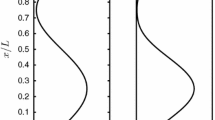Abstract
A Lagrangian stochastic model for the motion of heavy particles has been developed by coupling a stochastic model for the motion of fluid elements to the Stokes equations of motion of a particle in a turbulent flow. The effects of crossing trajectories and continuity are incorporated by generalising Csanady's (1963) ideas developed for stationary homogeneous turbulence; effects of turbulence inhomogeneity and nonstationarity are embodied in the stochastic model for the fluid motion.
The model has been used particularly to examine the effects of turbulence nonstationarity through simulations of the dispersion of heavy particles in the decaying homogeneous turbulence which is obtained by Taylor-transforming grid turbulence. Significant differences from the stationary case occur, mainly as a result of the growth of the turbulent time scale with time.
The importance of the source location in influencing both passive scalar and particle dispersion in grid turbulence is highlighted by the model and can be simply accounted for by nondimensionalisation using the r.m.s. turbulence velocity at the source and the mean travel time from the grid to the source as velocity and time scales, respectively. Reconciliation of the three different experiments of Snyder and Lumley (1971), Wells and Stock (1983) and Ferguson (1986) reporting heavy particle flow and dispersion statistics in wind tunnel grid turbulence has been attempted using this nondimensionalisation. A good correspondence between the various data sets was not obtained because the source in the Wells and Stock, and Ferguson experiments was located at the grid where the self-similar development of the turbulence which underlies the scaling is not appropriate.
The model matches the data for the heaviest particles used by Snyder and Lumley reasonably well. For very light particles, it correctly reverts to the passive scalar limit, while the experimental data in general do not properly approach this limit.
Similar content being viewed by others
References
Anand, M. S. and Pope, S. B.: 1985, ‘Diffusion Behind a Line Source in Grid Turbulence’, in L. J. S. Bradbury, F. Durst, B. E. Launder, F. W. Schmidt and J. H. Whitelaw (eds.), Turbulent Shear Flows, Vol. 4, pp. 46–52, Springer-Verlag.
Batchelor, G. K.: 1952, ‘Diffusion in a Field of Homogeneous Turbulence: II. The Relative Motion of Particles’, Proc. Camb. Phil. Soc. 48, 345–362.
Batchelor, G. K.: 1953, The Theory of Homogeneous Turbulence, Cambridge University Press.
Csanady, G. T.: 1963, ‘Turbulent Diffusion of Heavy Particles in the Atmosphere’, J. Atmos. Sci. 20, 201–208.
Comte-Bellot, G. and Corrsin, S.: 1966, ‘The Use of a Contraction to Improve the Isotropy of Grid Turbulence’, J. Fluid Mech. 25, 657–682.
Deardorff, J. W.: 1978, ‘Closure of Second- and Third-Moment Rate Equations for Diffusion in Homogeneous Turbulence’, Phys. Fluids 21, 525–530.
Ferguson, J. R.: 1986, ‘The Effects of Fluid Continuity on the Turbulent Dispersion of Particles’, Ph.D. thesis, Washington State University, Pullman.
Friedlander, S. K.: 1957, ‘Behaviour of Suspended Particles in a Turbulent Fluid’, A.I.Ch.E. Journal 3, 381–385.
Gardiner, C. W.: 1983, Handbook of Stochastic Processes for Physics, Chemistry and the Natural Sciences, Springer-Verlag.
Hinze, J. O.: 1975, Turbulence, McGraw-Hill.
Lumley, J. L.: 1978, ‘Two-Phase and Non-Newtonian Flows’, in P. Bradshaw (ed.), Turbulence, Topics in Applied Physics 12, 290–324.
Maxey, M. R.: 1987, ‘The Gravitational Settling of Aerosol Particles in Homogeneous Turbulence and Random Flow Fields’, J. Fluid Mech. 174, 441–465.
Meek, C. C. and Jones, B. G.: 1973, ‘Studies of the Behaviour of Heavy Particles a Turbulent Flow’, J. Atmos. Sci. 30, 239–244.
Nir, A. and Pismen, L. M.: 1979, ‘The Effect of a Steady Drift on the Dispersion of a Particle in Turbulent Fluid’, J. Fluid Mech. 94, 369–381.
Pasquill, F. and Smith, F. B.: 1983, Atmospheric Diffusion, (3rd edition), Ellis Horwood.
Pismen, L. M. and Nir, A.: 1978, ‘On the Motion of Suspended Particles in Stationary Homogeneous Turbulence’, J. Fluid Mech. 84, 193–206.
Reeks, M. W.: 1977, ‘On the Dispersion of Small Particles Suspended in an Isotropic Turbulent Fluid’, J. Fluid Mech. 83, 529–546.
Reeks, M. W.: 1983, ‘The Transport of Discrete Particles in Inhomogeneous Turbulence’, J. Aerosol Sci. 14, 729–739.
Sawford, B. L. and Guest, F. M.: 1988, ‘Uniqueness and Universality of Lagrangian Stochastic Models of Turbulent Dispersion’, Extended abstract, 8th Symposium on Turbulence and Diffusion, April 25–29, San Diego, California. AMS.
Shih, T. H. and Lumley, J. L.: 1986, ‘Second-Order Modelling of Particle Dispersion in a Turbulent Flow’, J. Fluid Mech. 163, 349–363.
Snyder, W. H. and Lumley, J. L.: 1971, ‘Some Measurements of Particle Velocity Autocorrelation Functions in a Turbulent Flow’, J. Fluid Mech. 48, 41–71.
Tchen, C. M.: 1947, ‘Mean Value and Correlation Problems Connected with the Motion of Small Particles Suspended in a Turbulent Flow’, Ph.D. thesis, Delft; The Hague, Martinus Nijhoff.
Thomson, D. J.: 1987, ‘Criteria for the Selection of Stochastic Models of Particle Trajectories in Turbulent Flows’, J. Fluid Mech. 180, 529–586.
Townsend, A. A.: 1976, The Structure of Turbulent Shear Flow. Cambridge University Press.
Wells, M. R. and Stock, D. E.: 1983, ‘The Effects of Crossing Trajectories on the Dispersion of Particles in a Turbulent Flow’, J. Fluid Mech. 136, 31–62.
Yudine, M. I.: 1959, ‘Physical Considerations on Heavy Particle Diffusion’, Adv. Geophys. 6, 185–191.
Zhuang, Y., Wilson, J. D., and Lozowski, E. P.: 1989, ‘A Trajectory-Simulation Model for Heavy Particle Motion in Turbulent Flow’, J. Fluids Eng. 111, 492–494.
Author information
Authors and Affiliations
Rights and permissions
About this article
Cite this article
Sawford, B.L., Guest, F.M. Lagrangian statistical simulation of the turbulent motion of heavy particles. Boundary-Layer Meteorol 54, 147–166 (1991). https://doi.org/10.1007/BF00119417
Accepted:
Issue Date:
DOI: https://doi.org/10.1007/BF00119417




